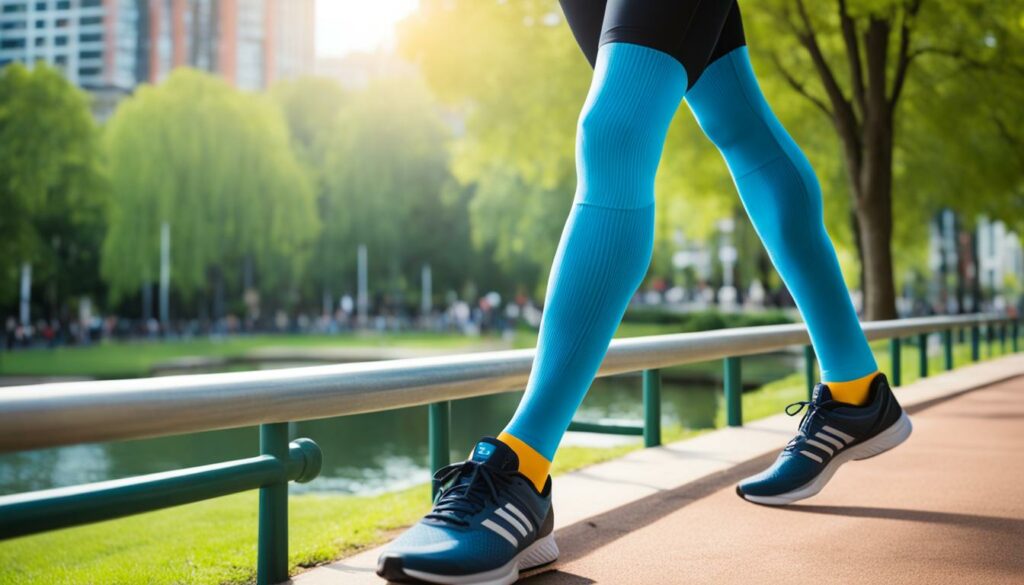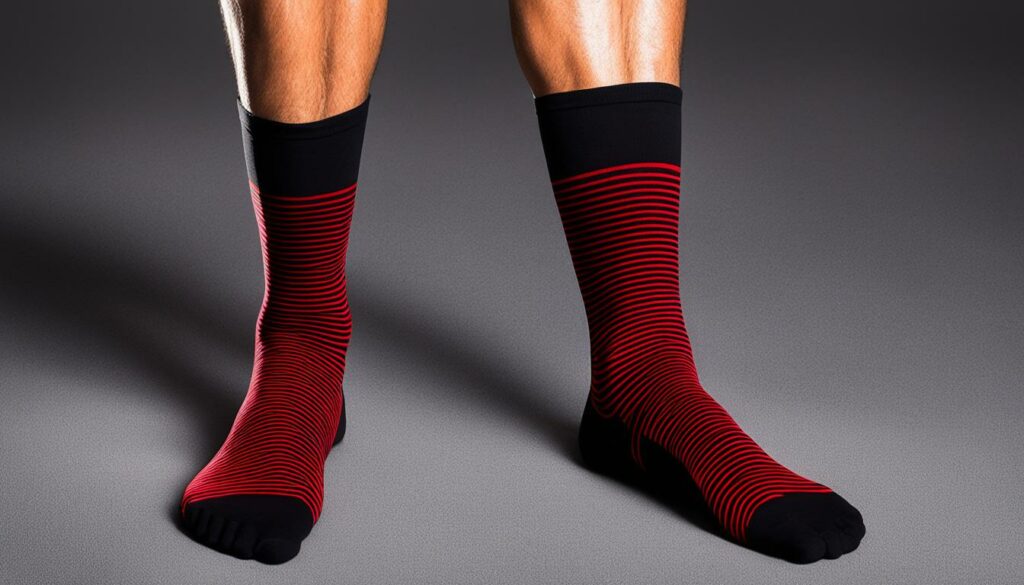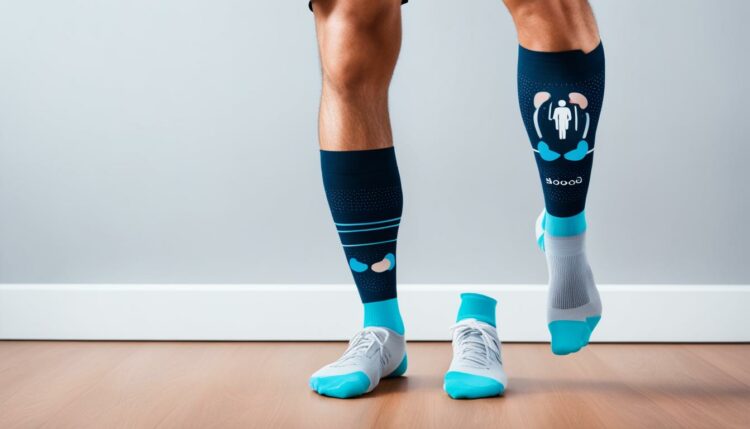Compression socks, also known as compression stockings, are specially designed, snug-fitting socks that apply gentle pressure to your legs to improve circulation. They can help reduce pain, swelling, and the risk of blood clots.
Compression socks are commonly used by athletes, those at risk for circulation problems, people recovering from surgery, pregnant women, and frequent travelers. They come in different lengths and tightness levels, allowing for personalized use.
Compression stockings are safe for most people, although there are potential side effects such as skin irritation and discomfort if not worn correctly.
Key Takeaways:
- Compression socks improve circulation and reduce pain, swelling, and the risk of blood clots.
- They are commonly used by athletes, individuals at risk for circulation problems, and those recovering from surgery.
- Compression socks come in different lengths and tightness levels for personalized use.
- Potential side effects of compression socks include skin irritation and discomfort if not worn correctly.
- It is important to consult with a healthcare provider and follow guidelines for proper use of compression socks.
How Compression Socks Work
Compression socks are designed to improve circulation and prevent blood from pooling and clotting in the legs. They work by exerting pressure on the legs, which aids in the movement of blood back up to the heart.
Two commonly used types of compression socks are graduated compression stockings and thrombo-embolic deterrent (TED) hose.
Graduated Compression Stockings
Graduated compression stockings are the most commonly used type of compression socks. They are designed to be tightest around the ankle and gradually decrease in pressure as they go up the leg. This graduated pressure helps push oxygen-rich blood from the feet back up to the heart.
By improving blood flow, graduated compression stockings can reduce swelling, alleviate pain, and lower the risk of blood clots.
Thrombo-embolic Deterrent (TED) Hose
Thrombo-embolic deterrent (TED) hose is another type of compression stocking that is primarily used for individuals who are bedridden or require extended periods of bed rest. These stockings help maintain blood circulation in the legs and reduce the risk of severe swelling.
TED hose are often recommended for postoperative patients or those at high risk of deep vein thrombosis (DVT).
| Type of Compression Sock | Description |
|---|---|
| Graduated Compression Stockings | Tightest around the ankle and gradually decrease in pressure as they go up the leg |
| Thrombo-embolic Deterrent (TED) Hose | Primarily used for individuals who are bedridden or require extended periods of bed rest |
Benefits of Compression Socks
Compression socks offer several benefits for those who wear them correctly. The key advantages of wearing compression socks include:
1. Improved Circulation: Compression socks exert pressure on the legs, helping to improve blood flow. This improved circulation promotes better oxygenation of muscles and reduces the risk of blood clots.
2. Reduced Pain and Discomfort: Compression socks can help alleviate pain and discomfort in the legs. The gentle compression provides support and reduces muscle fatigue, making them ideal for individuals who spend long periods on their feet or have circulation issues.
3. Reduced Swelling: Compression socks are effective in reducing swelling in the legs, feet, and ankles. The controlled pressure applied by the socks helps prevent fluid retention and aids in the movement of excess fluid back towards the heart.
4. Faster Exercise Recovery: Athletes and active individuals can benefit from wearing compression socks during and after exercise. The graduated compression stimulates blood flow, resulting in faster recovery times, reduced muscle soreness, and improved performance.

Overall, compression socks are a valuable tool for promoting leg health and well-being. They offer improved circulation, reduced pain and discomfort, reduced swelling, and faster exercise recovery. Whether used for medical reasons or as a performance-enhancing aid, compression socks provide numerous benefits for individuals of all ages and activity levels.
Types of Compression Socks
When it comes to compression socks, there are different types that cater to varying needs and conditions. Understanding the different options available can help individuals choose the most suitable compression socks for their specific requirements.
Nonmedical Support Hosiery
Nonmedical support hosiery refers to compression socks that can be purchased over the counter without a prescription. These socks are designed for everyday use and provide mild compression to promote leg health.
They are commonly worn by individuals who spend long hours on their feet, such as retail workers, nurses, and travelers. Nonmedical support hosiery is available in various styles and compression levels to accommodate personal preferences.
Graduated Compression Socks
Graduated compression socks are the most commonly used type of compression socks for medical conditions. These socks feature a design that applies different levels of pressure along the leg.
The pressure is highest at the ankle and gradually decreases as it moves up the leg. This graduated compression helps improve blood flow, reduce swelling, and prevent blood clots.
Proper fitting is crucial for maximizing the benefits of graduated compression socks, and professional guidance is recommended to ensure the correct size and pressure level are selected.
Anti-Embolism Compression Socks
Anti-embolism compression socks are specifically prescribed for individuals who are at a higher risk of developing pulmonary embolisms. These socks are commonly used by individuals with limited mobility or those recovering from surgery.
The primary purpose of anti-embolism compression socks is to maintain proper blood circulation and prevent deep vein thrombosis. They are typically knee-length and provide a specific compression range that is tailored to the individual’s condition and needs.
Here is a table summarizing the different types of compression socks and their main characteristics:
| Type of Compression Socks | Main Characteristics |
|---|---|
| Nonmedical Support Hosiery | Available over the counter Mild compression for everyday use Different styles and compression levels |
| Graduated Compression Socks | Requires professional fitting Pressure is highest at the ankle and decreases upwards Used for medical conditions |
| Anti-Embolism Compression Socks | Prescribed for high risk of pulmonary embolisms Suitable for limited mobility and post-surgery recovery Primarily knee-length |
Choosing the appropriate type of compression sock depends on individual needs and medical conditions. Professional advice should be sought to ensure the best-suited compression sock is selected.
How to Choose and Wear Compression Socks Correctly
When it comes to compression socks, choosing the right stocking is essential for optimal benefits and comfort. Here’s a guide to help you make the right selection and wear compression socks correctly.
1. Choose the Right Compression Stocking
To choose the right compression stocking, you need to consider the correct compression level based on your needs and condition. Compression levels are measured in millimeters of mercury (mmHg) and range from mild (8-15 mmHg) to moderate (15-20 mmHg), firm (20-30 mmHg), and extra firm (30-40 mmHg).
Different compression levels provide varying levels of pressure and support. Mild compression socks are generally suitable for daily use, while higher compression levels may be recommended for specific medical conditions or athletic performance.
2. Ensure Proper Fit and Sizing
Proper fit and sizing are crucial for the effectiveness of compression socks. It is recommended to have your socks fitted by a professional, such as a certified fitter or healthcare provider. Measurements should be taken when your legs are least swollen, usually in the morning.
Compression socks should fit snugly but comfortably, without being too tight or constricting. They should provide enough compression to exert pressure on your legs and improve blood flow but not to the point of causing discomfort or cutting off circulation.
3. Wearing Compression Socks Correctly
Wearing compression socks correctly is equally important as choosing the right stocking and size. Here are some tips:
Smooth application: Ensure a smooth application of the socks, starting from the toes and gradually pulling them up without folding or rolling the tops down. Smooth out any wrinkles or bunching to ensure consistent compression along the leg.
Avoid tight socks: Do not wear socks that are too tight, as this can lead to discomfort and circulation issues. If the socks leave deep marks on your skin or cause excessive redness, consider a lower compression level or consult a healthcare professional.
Replace regularly: Compression socks should be replaced every 3 to 6 months or as recommended by the manufacturer. Over time, the elastic fibers may lose their effectiveness, reducing the compression and support provided by the socks.
Follow doctor’s recommendations: Always follow your doctor’s recommendations regarding the frequency and duration of wearing compression socks. They will provide guidance based on your specific needs and condition.
By choosing the right compression stocking, ensuring a proper fit and size, and wearing compression socks correctly, you can maximize their benefits for improved circulation, reduced pain and discomfort, and better leg health.
| Compression Level | Pressure Range (mmHg) | Recommended Use |
|---|---|---|
| Mild | 8-15 | Daily wear, prevention of mild symptoms |
| Moderate | 15-20 | Mild to moderate symptoms, post-workout recovery |
| Firm | 20-30 | Moderate to severe symptoms, medical conditions |
| Extra Firm | 30-40 | Severe symptoms, specific medical conditions |
Potential Side Effects of Compression Socks
While compression socks are generally safe when worn correctly, it’s important to be aware of potential side effects. Understanding these side effects can help individuals make informed decisions about whether compression socks are the right choice for them.
Skin Irritation
One potential side effect of wearing compression socks is skin irritation. This can manifest as itching, redness, or discomfort. Skin irritation is more likely to occur when wearing socks made from low-quality materials or if an individual is allergic to certain fabrics.
Restricted Circulation
Improperly fitted compression socks or socks that are too tight can restrict circulation instead of improving it. This can result in discomfort and potentially worsen existing circulation issues. It’s important to choose the right size and compression level to avoid this side effect.
Bruising or Chafing
If compression socks are not properly fitted, they can cause bruising or chafing. This occurs when the socks apply too much pressure or rub against the skin. It’s essential to ensure a proper fit to prevent these side effects.
Leg Achiness
In some cases, individuals may experience leg achiness after wearing compression socks. This is usually a result of wearing socks that are too tight or not properly sized. Discomfort and pain in the legs should not be ignored and may indicate the need for adjustment or reevaluation of sock size.
It’s crucial to note that while these potential side effects exist, they are not experienced by everyone who wears compression socks. By choosing high-quality socks, wearing them correctly, and monitoring any discomfort, individuals can minimize the risk of side effects and enjoy the benefits of improved leg health.
Comparison of Potential Side Effects
| Side Effect | Description |
|---|---|
| Skin Irritation | Itching, redness, or discomfort caused by wearing low-quality materials or being allergic to certain fabrics. |
| Restricted Circulation | Discomfort and potential worsening of circulation issues due to improperly fitted or overly tight socks. |
| Bruising or Chafing | Bruises or skin irritation caused by excessive pressure or rubbing from ill-fitting compression socks. |
| Leg Achiness | Discomfort and pain in the legs resulting from wearing socks that are too tight or not the correct size. |
Can Wearing Compression Socks Be Harmful?
Despite their many benefits, there are several myths and misconceptions surrounding the use of compression socks. Let’s address some of these and shed light on the truth.
Myth: Compression socks cut off circulation
Fact: Contrary to popular belief, compression socks do not cut off circulation when worn correctly. In fact, they are specifically designed to improve circulation and prevent blood clots. The gentle pressure exerted by compression socks helps promote blood flow and enhance the efficiency of the circulatory system.
Myth: Compression socks cause bruising and chafing
Fact: Compression socks made from high-quality materials should not cause bruising or chafing. When properly fitted and worn, compression socks should provide a snug yet comfortable fit. It is essential to choose the correct size and level of compression to avoid any discomfort or skin irritation.
Myth: Compression socks are only for older or bedridden individuals
Fact: Compression socks are not limited to older or bedridden individuals. They can benefit individuals of all ages and activity levels. Athletes, runners, pregnant women, and individuals who spend long hours standing or sitting can all find value in wearing compression socks.
The graduated pressure they provide can aid in reducing fatigue, preventing muscle soreness, and enhancing performance and recovery.
“Compression socks are a helpful tool for promoting leg health. They are designed to improve circulation and provide support for veins while preventing blood clots. These socks can benefit a wide range of individuals, from athletes to those with specific medical conditions.”
It is important to debunk these myths and understand the true benefits of compression socks. By wearing these socks correctly, individuals can experience positive effects on their leg health and overall well-being.

Conclusion
In conclusion, compression socks provide numerous benefits for individuals seeking to improve leg health and overall well-being. The key advantages of wearing compression socks include improved circulation, reduced pain and discomfort, and faster exercise recovery.
By applying gentle pressure to the legs, compression socks stimulate blood flow, helping to prevent blood clots and reducing swelling in the legs, feet, and ankles.
However, it is crucial to wear compression socks correctly and choose the appropriate size and compression level. Ill-fitting socks or socks made from low-quality materials can lead to potential side effects such as skin irritation and restricted circulation.
Therefore, it is recommended to seek guidance from a healthcare provider or professional to ensure the proper fit and use of compression socks.
Overall, compression socks are a valuable tool in promoting leg health and managing various conditions, such as varicose veins and circulation problems. Their benefits outweigh the potential side effects when used correctly.
To maximize the advantages of compression socks and minimize the risks, individuals should consult with their healthcare provider, follow guidelines for proper use, and replace socks regularly for optimal results.
FAQ
What are compression socks?
Compression socks, also known as compression stockings, are specially designed, snug-fitting socks that apply gentle pressure to your legs to improve circulation.
Who should use compression socks?
Compression socks are commonly used by athletes, those at risk for circulation problems, people recovering from surgery, pregnant women, and frequent travelers.
How do compression socks work?
Compression socks work by exerting pressure on the legs, which helps improve blood flow and prevent blood from pooling and clotting. Graduated compression stockings are the most commonly used type and are tightest around the ankle, gradually decreasing in pressure as they go up the leg.
What are the benefits of compression socks?
Compression socks can improve circulation, reduce pain and discomfort, lessen swelling in the legs, feet, and ankles, and provide support for veins to prevent or treat varicose veins. Athletes may also experience faster recovery and reduced muscle soreness when wearing compression socks.
What are the different types of compression socks?
There are various types of compression socks available, including nonmedical support hosiery for everyday use, graduated compression socks for medical conditions, and anti-embolism compression socks prescribed for individuals at higher risk of pulmonary embolisms.
How do I choose and wear compression socks correctly?
To choose the right compression stockings, it is important to select the correct compression level based on your needs and condition. Socks should be properly fitted by a professional, and measurements should be taken when legs are least swollen. It is important to avoid wearing socks that are too tight, and socks should be replaced every 3 to 6 months.
Are there any side effects of wearing compression socks?
Potential side effects of wearing compression socks include skin irritation, restricted circulation if socks are too tight, and bruising or chafing if socks are not properly sized.
Can wearing compression socks be harmful?
No, wearing compression socks correctly is not harmful. However, there are some myths surrounding compression socks, such as cutting off circulation or causing bruising and chafing. These misconceptions are not true when socks are worn properly and made from quality materials.
Are compression socks beneficial for everyone?
Compression socks can be beneficial for individuals of all ages and activity levels, as long as they are worn correctly. They are not only for older or bedridden individuals.








